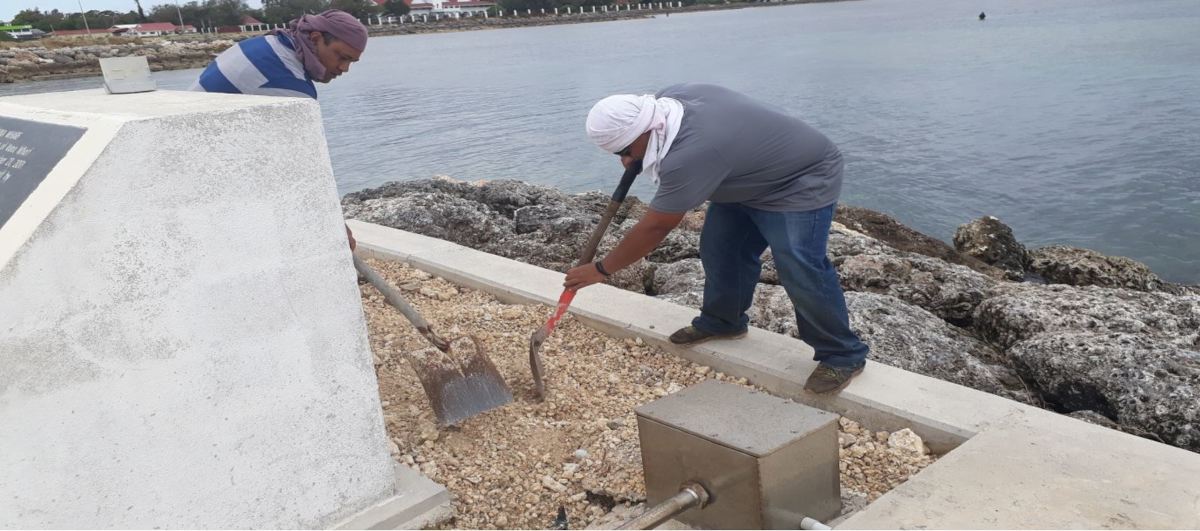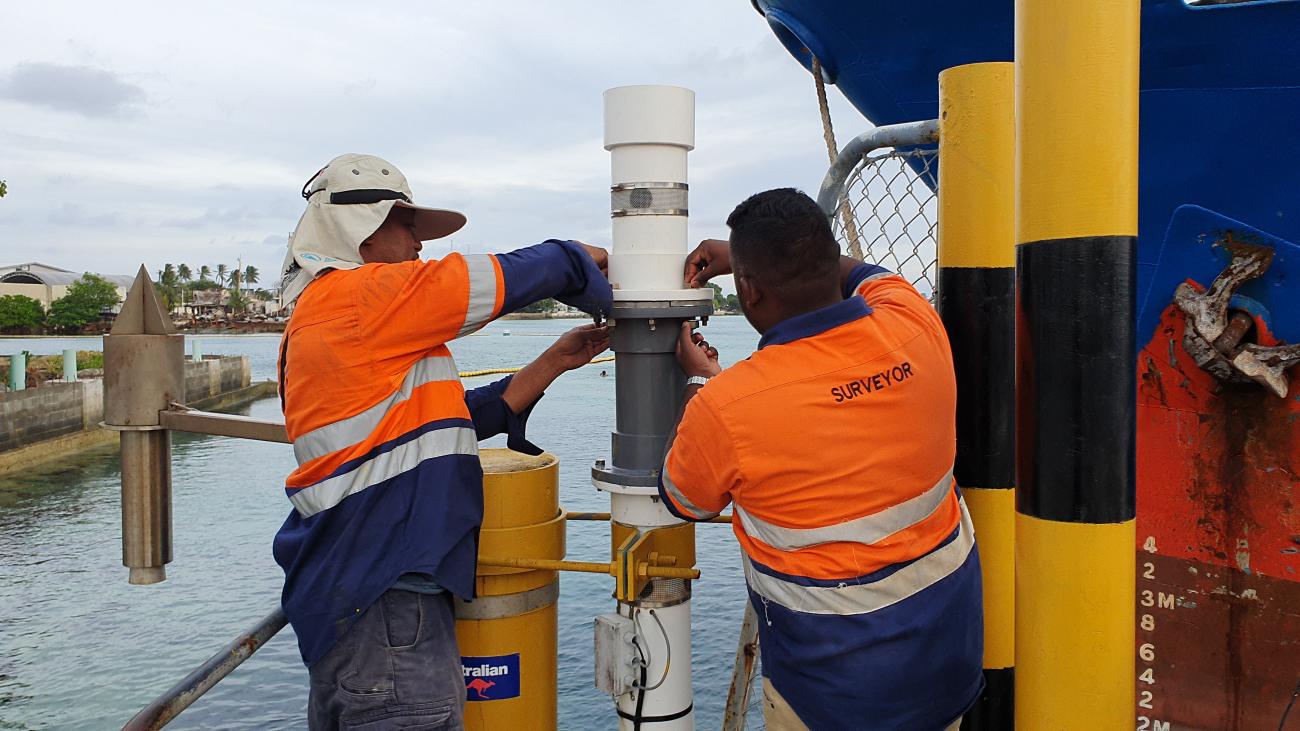Picture: SPC technical and geodetic surveying team at the Majuro tide gauge station in the Marshall Islands (RMI)
As the Intergovernmental Oceanographic Commission (IOC-UNESCO) reported earlier this year, COVID-19 has caused massive disruptions to ocean observing systems around the globe, as research cruises, maintenance visits, and sensor deployments have been postponed or cancelled.
According to IOC-UNESCO, “COVID-19 created an ocean data blindspot that could disrupt weather forecasts and hamper our understanding of climate change.”
When borders closed around the Pacific in March as part of COVID-19 restrictions, it provided an opportunity to test the agility of the infrastructure maintenance program supporting 13 permanent sea level observation stations across the Pacific.
These stations form the backbone of one of the world’s most important ocean-monitoring networks. They provide an indispensable record and near-real time data for meteorological agencies, emergency services, shipping operators, and all coastal communities concerned with the rate of sea-level rise and climate change.
Pacific sea level monitoring
The Australian Bureau of Meteorology (BoM) manages the tide gauges in partnership with the Pacific Community (SPC) and Geoscience Australia (GA) through the Pacific Sea Level and Geodetic Monitoring (PSLGM) project. As one of the region’s oldest continuing aid investments, this project has provided continuous, high-quality climate, sea-level, and land movement data since 1991, and currently operates under the Climate and Oceans Support Program in the Pacific (COSPPac).
Pre-COVID-19, technicians from BOM, SPC, or GA would travel monthly throughout the region to undertake maintenance, calibration, or levelling of each sea-level monitoring site and attend to any emergency issues that might arise.
But COVID-19 has accelerated a process already underway to build in-country capacity to maintain and troubleshoot these sites. Following are a few success stories that have emerged from the project over the last six months.
6-monthly infrastructure maintenance
SPC team members have trained in-country technicians to conduct routine maintenance of the sea level monitoring stations over the last two years.
“The maintenance of this essential measurement equipment is a crucial component for the continuity of quality data collection,” said Adrien Laurenceau-Moineau, the Technical Team Leader at SPC’s Geoscience, Energy and Maritime Division.
Once trained, technical staff of the Meteorological Office and Lands and Survey Department conduct this basic maintenance every six months, following a purpose-designed checklist. Sea-level observing stations and sensors are cleaned and any damage or deterioration are noted and reported to SPC and BoM.
Since March, maintenance has been completed at ten sites in the Cook Islands, Fiji, Marshall Islands, Federated States of Micronesia, Samoa, Tonga, Kiribati, Solomon Islands, Tuvalu and Vanuatu.
In August 2020, the Fiji Meteorological Service (FMS) technical team worked alongside SPC to perform the 6-monthly maintenance check at the sea-level observing station at the Queen’s wharf in Lautoka.
Return to Service
When Tropical Cyclone Harold struck Tonga in April 2020, the old tide gauge on the Queen Salote wharf in Nuku’alofa was damaged by waves. At the new station on Vuna Wharf, waves washed away the gravel protecting the station conduits and the station was off-line due to a power and communication failures.

The in-country teams took the lead to implement established Return to Service procedures set up under the project.
Viliami Folau of Tonga’s Land and Survey Department conducted a site visit and provided BoM with pictures, updating the status of both tide stations in Nuku’alofa.
“Post-disaster assessment of the tide gauges is critical. It documents damages, if any, to the infrastructure and ensures the quick return to service of this important source of real-time data collection,” he noted.
Tonga Meteorological Service technician, Enisi Maea, was assisted remotely by BoM to investigate and identify the fault causing the system to go offline. In partnership with Tonga Power and the Ports Authority, Enisi was able to resolve the issue and bring the station back online.
Similarly, Solomon Islands Met Service technical officer, Barnabas Tahoo, took the lead in getting the Honiara tide gauge station back online. Contractors had removed the main power to the station for a wharf extension project back in March when the contractors were suddenly required to return to Australia due to the COVID-19 lockdown.
Barnabas worked with BoM to troubleshoot a solution and was able to install a temporary power extension from a nearby shed until the permanent main can be restored.
Station upgrades
Inspite of COVID-19 challenges, planned upgrades to a number of stations have been able to go ahead as planned with remote support and supervision.
In Port Vila and Rarotonga a dual radar sensor platform was installed by local contractors with assistance from the Vanuatu Meteorological Service and the Cook Islands Meteorological service with remote oversight from BoM. The new platform will provide the stations with an additional sensor to monitor the sea level as well as a GNSS receiver antenna.
Likewise, the Suva and Lautoka stations in Fiji were refurbished and a dual sea level radar sensor mount was installed by local contractors and SPC supervision.
Remote capacity building
While the situation presents many challenges, Jeff Aquilina, the PSLGM Team Leader at the Australian Bureau of Meteorology has embraced the shift to remote support for the project where feasible. He notes, “This infrastructure maintenance work is building a stronger relationship between us and the technical staff of the Pacific Island countries, building equipment knowledge, technical capacity and a sense of ownership of the tide station in each country.”
“This is a positive outcome of the investment in training, mentoring, in-country visits and the establishment of strong networks in the Pacific,” adds Jeff. “At the end of the day, the aim is to ensure the stations are fully operational, recording crucial datasets.”
“This really drives home the importance of investing in local capacity building,” says Molly Powers-Tora, COSPPac Coordinator and Team Leader for Ocean Intelligence at SPC. “And the fact that overworked national staff are committed to the upkeep of these stations is a reflection of just how valuable this data is to the Pacific.”
For more information, contact:
Merana Kitione, Capacity Development & Communications Officer | [email protected]
Useful links:
COSPPAC: Pacific sea level monitoring project
GEM wesbite: COSPPAC Project
UNESCO: Covid-19 disruptions ocean observations could threaten weather forecast and climate change
